
Turkey
Istanbul, "the magnificent"![[Unesco]](/images/unesco-logo.gif)
![[+]](/images/icone-etoile.png)
Istanbul is located on two continents : Europe and Asia which are divided by the Bosphorus Strait connecting the Sea of Marmara to the Black Sea. The city is spread over more than 100 km (60 miles). Fortunately the interesting spots are concentrated within a few kilometers !
Traffic is chaotic and it is better to give up the car. Moreover taxis are numerous and affordable. There are also "dolmus" which are shared taxis waiting until the vehicle is full to go.
The mosques can be visited but not during prayers and one must take off one's shoes before entering. Sometimes the shoes must be left outside and sometimes they can be taken in a plastic bag given at the entrance. Besides women have to cover their hair.
I only visited the European part as this is where the most famous monuments are located.
A bit of History...
Founded in the 7th century BC by the Greeks, the city of Byzantium was conquered several times (Persians, Greeks...) before becoming part of the Roman province in the 2nd century BC.
It was chosen by the Emperor Constantine as the new capital of the Eastern Roman Empire in 330 AD and was renamed Constantinople : it was then the "new Rome."
The barbarian invasions did not reach it and while the Western Roman Empire collapsed it increasingly became important to reach its peak under Justinian in the 6th century with an Empire
called the Byzantine Empire that stretched from Greece to Anatolia but also Italy, southern Spain and North Africa. In 1054, it became Orthodox after the schism with the Roman church.
In 1204, the Venetians diverted the 4th crusade to plunder Constantinople. After an exile at Nicaea, the Byzantine leaders managed to retake Constantinople in 1261. But the Empire had been weakened and then kept losing territories... The Byzantine civilization ended with the fall of Constantinople during the Ottoman invasion led by Sultan Mehmet II in 1453. The Ottomans used cannons to destroy the sturdy battlements. The city was renamed Istanbul and then became the capital of the Ottoman Empire. The inhabitants are called Istanbulites.
Atatürk moved the capital to Ankara in 1923.
Hagia Sophia
This is one of the most visited monuments in the world.
The ancient Byzantine basilica was dedicated to Divine Wisdom (Sophia means wisdom in Greek) and was built by Emperor Justinian in 537 AD. Symbol of Constantinople, it was then the largest Christian basilica in the world. It has been preserved as a legacy by the Ottomans and converted into a mosque after the conquest. First with a minaret (the brick minaret), it was turned to an imperial mosque with an addition of three stone minarets (one thin and two thicks). It is a museum since 1934.
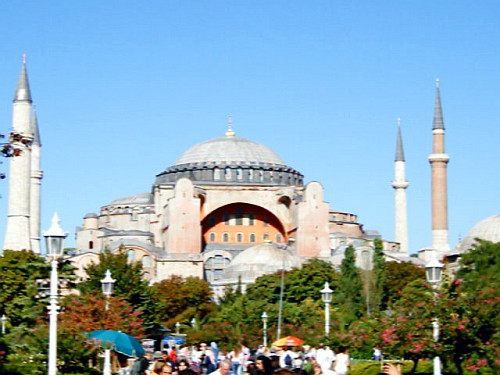
Arcs boutans were added to support the weight of the basilica outside. To the left of the entrance, a few vestiges of old collapsed cathedrals were excavated. Nearby, a fountain was used for washing the feet of the faithful when the cathedral was used as a mosque.
After going through the exonarthex (which was used as a meeting point) and the narthex we come in the heart of Hagia Sophia.
The great dome could not be as great as what was originally planned as the architect who led the work died before its completion. It is even possible to see some traces of shortening. The nave is spectacular (columns come from Ephesus and Egypt) and there are mosaics on the floor. As in most mosques, there are signs in Arabic calligraphy.
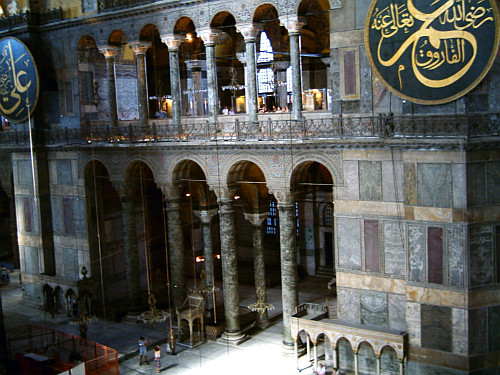
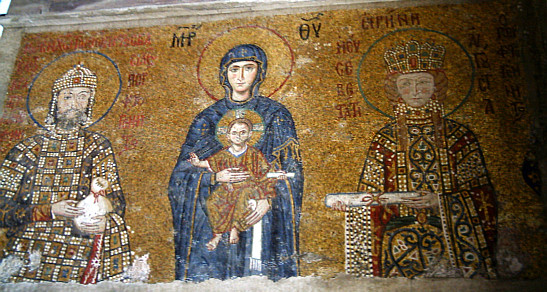
At the altar place, we can see the sultan's lodge to the left, the mihrab at the center (niche indicating the direction of Mecca) and the minbar (Muslim pulpit) to the right.
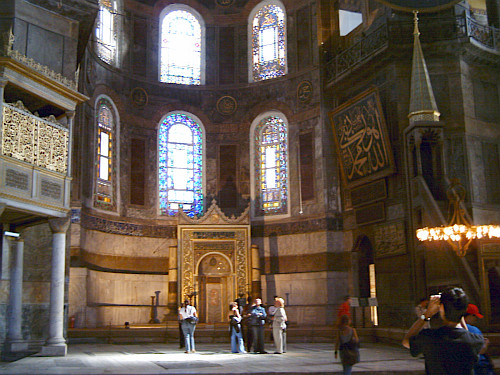
On the ground, to the right, there is a marble mosaic which marked the place of the omphalos ie the center of the world where Byzantine emperors were crowned.
A legend says that during the fall of Constantinople the patriarch took refuge in a secret passage which entrance collapsed after him. He should come back when the city would become Christian again.
Blue Mosque
Commissioned by Sultan Ahmet I and built from 1609 to 1616 by a student of great architect Sinan, the blue mosque was to be the world's largest and more significant mosque before the one in Mecca. It also had to be the starting point for the conquest of the world. The number of minarets was a symbol of power and as the mosque of Mecca had five, it was therefore put six. Actually, the mosque of Mecca took over with the addition of a sixth and then seventh minaret.
Nowadays, the blue mosque is the fifth largest mosque in Turkey.
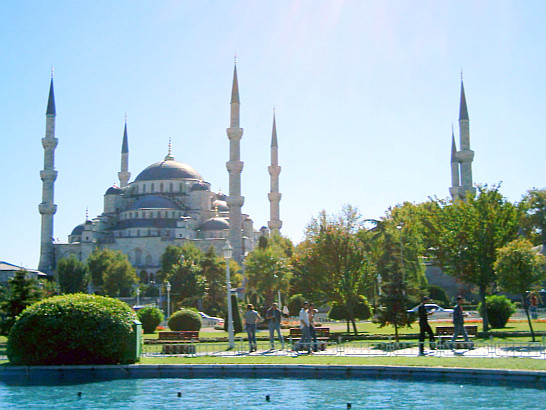
The religious purpose of the minaret is to have the calls to the five daily prayers made by the muezzin at its summit.
From the courtyard, there is a beautiful view on the domes making me think of a waterfall...
Inside, as in any mosque, we can see the mihrab (niche indicating the direction of Mecca), the minbar (sort of pulpit of the Imam), the carpet with markings for the faithful.
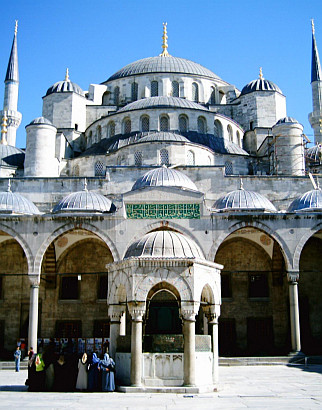
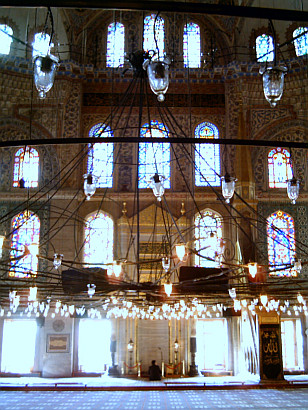
The clarity is outstanding and our attention is drawn by the rendering of Iznik ceramics and stained glass, visible from the inside but not from the outside (as it is a symbol of the human soul). Its name comes from the color of its blue interior with Iznik tiles. Now restored, it appears less blue than at the beginning, except in some places as the top of the pillars.
Prayer carpets (called zarbiya in Maghreb) are oriented towards Mecca. This carpet is also used by the faithful outside mosques to precisely represent the mosque.
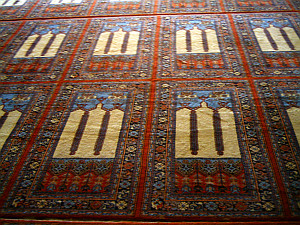
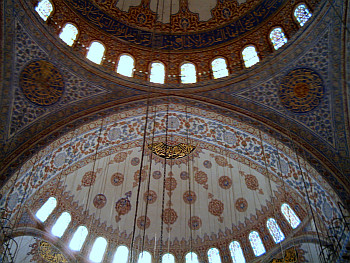
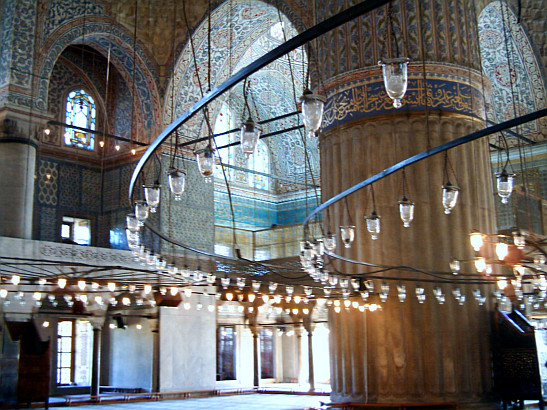
There is a symbolic meaning for the colours. Thus the green is used for Muslim religion, the blue for Heaven, and the red for the family. We find no human representation (no statue, no picture nor icon) because it is strictly forbidden in Islam.
Ahmet III fountain
Between Hagia Sophia and the Topkapı palace entrance, we can not miss the ablutions fountain of Ahmet III with a rococo decoration. It is one of the most beautiful ablutions fountains in Istanbul but this one is no longer used.
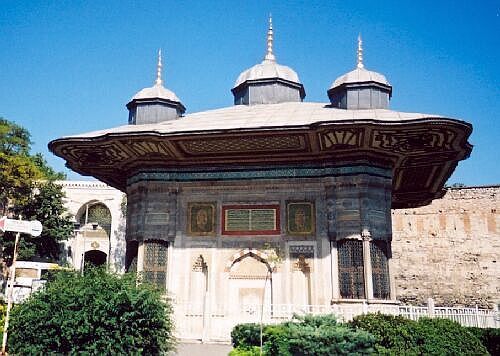
Basilica Cistern
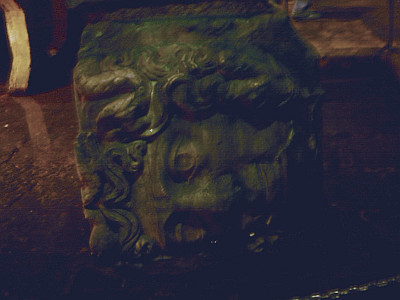
As Hagia Sophia, next to which it is located, the Basilica Cistern was built during the reign of Justinian (in 532 to be accurate). It was used to cover the needs of the great palace with water (note : The great palace of Constantinople was destroyed and replaced by the Topkapı Palace).
We can walk between the huge Corinthian columns of the underground lit with dim lights. Traditional music can be heard by the visitors on the way to the two pillars which stone base is carved with a huge mythological head of Medusa (whose glance could petrify).
The significance of these statues in a cistern is not yet known.
There is even real fish...
Hippodrome
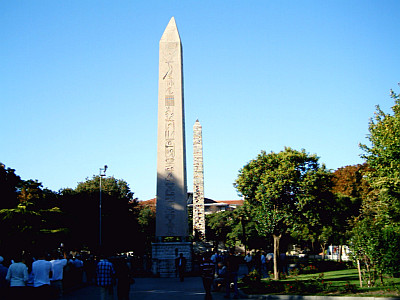
There is not much left of the old hippodrome except two obelisks : the Walled Obelisk (or Constantine Obelisk) of 32 m (105 feet) high and the imposing obelisk of Theodosius of around 19 m (62 feet) high which comes from Luxor (like the one of Place de la Concorde in Paris). A base with chariot races engravings is added to it.
Between these two columns there is the rest of the serpentine column representing a three-headed serpent which symbolized the "Middle East" to the Byzantines. One of the heads is now in the Museum of London, the second in the Archaeological Museum of Istanbul and the third seems lost forever.
Topkapı palace
Topkapı is pronounced roughly Topkap[eu] as the ı is similar to i in "cousin".
The palace was built on the site of the Great Palace of Constantinople after the conquest of the city by the Ottomans. Located on a hill, it also provide a nice view over the Golden Horn.
Below the main entrance called gate of Salutation and the next entrance called gate of Felicity.
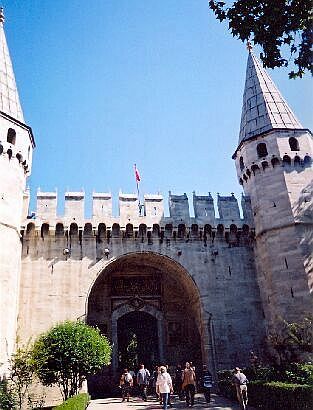
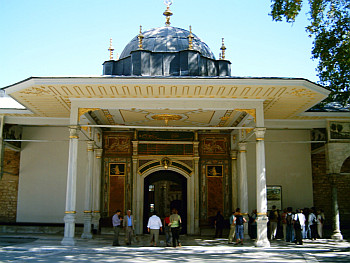
The palace is comprised of several buildings and some of them are now museums : small ceramics museum in kitchens, small museum of geographer instruments, small museum of imperial costumes, small museum of arms and armor. There is also the circumcision room and the chamber of the Sacred Relics where an imam recites prayers and which houses hairs from the beard of Prophet Muhammad, an imprint of his foot, one of his teeth, his bow and his mantle. It is a place of pilgrimage in Islam.
Below, a nicely decorated fountain.
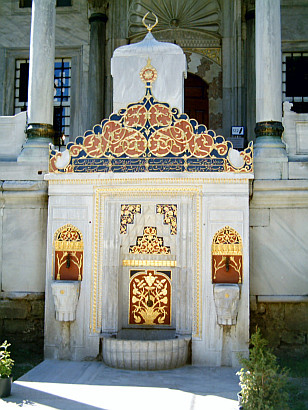
But the core of the visit is the treasure (including the famous sultan's dagger, decorated with precious stones, and the largest diamond in the world) and the harem, with nicely decorated ceramics.
The harem (or seraglio which is a restrictive term to the Ottoman Empire whereas the term harem applies to all Muslim cultures) was the place where lived the sultan's concubines among whom one could hope to become his wife if one gave him a son. But the mother and daughters of the Sultan also lived there. There could be up to a thousand women (in four hundred rooms). The corridors were guarded by the eunuchs.
Below, the imperial hall where the sultan chose his concubine, and a niche for candles.
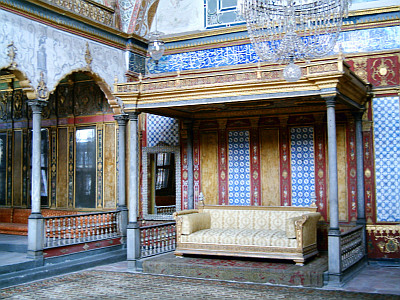
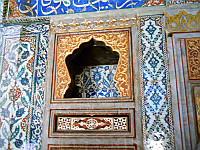
During the visit, we also access the Sultan's room and the concubines' bathroom.
Süleymaniye Mosque
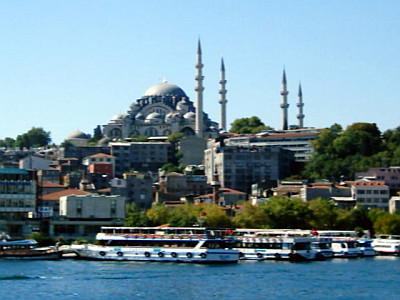
The four minarets indicate that it is an imperial mosque. The building is surrounded by other buildings with domes. We can also visit the adjoining cemetery where are tombs of Süleyman and his wife Roxelana.
Roxelana was a former Orthodox Christian captive, maybe from Galicia (a territory between Poland and Ukraine). Chosen to be part of the harem of the Sultan, she managed to obtain his favors and converted to Islam. She then asked Süleyman to marry her arguing that a free Muslim woman could not maintain a relationship with a man outside marriage. She thus became his only legal wife.
While Süleyman wanted to build a new palace, Roxelana, fearing the construction of a new large harem, diverted his mind by asking him to rather build a mosque. The greatest architect of the Empire, Sinan, was charged to achieve this construction. Between 1549 and 1557, Sinan realized the largest mosque of Istanbul.
The gardens of the mosque are one of the places (with Hagia Sophia and the Blue Mosque) where we can meet sellers of fruit juice in traditional dress. Their cherry juice is quite good.
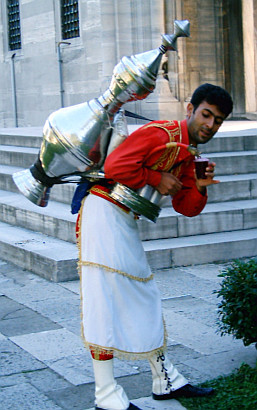
The Grand Bazaar
A must see ! This is a very large covered market (which exists since the 15th century) where we find everything : hookah as souvenir, carpets, shoes, leather, jewelry, Turkish delight... There is even a small post office among 4,000 shops.
No price is displayed. We must ask the sellers who speak mostly English or French, and try to haggle if the price seems too expensive...
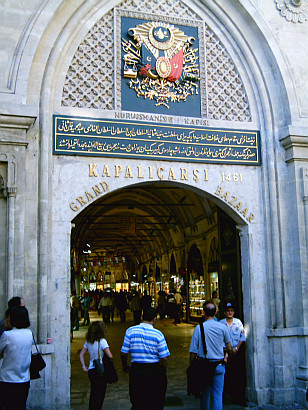
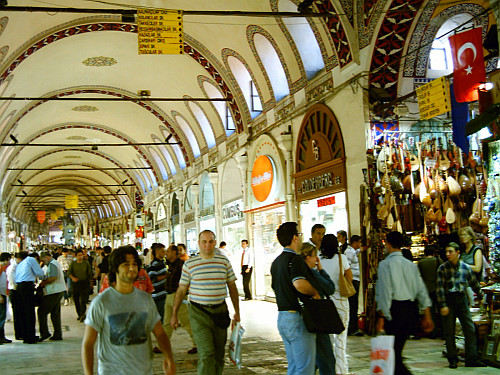
The district of Egyptian Bazaar
The Egyptian Bazaar is another bazaar of the city but less important than the Grand Bazaar and more specialized in spices and Turkish delight.
Near the bazaar, we can visit the Rüstem Pacha mosque and go to the new mosque (below) which interior is decorated with Iznik ceramics.
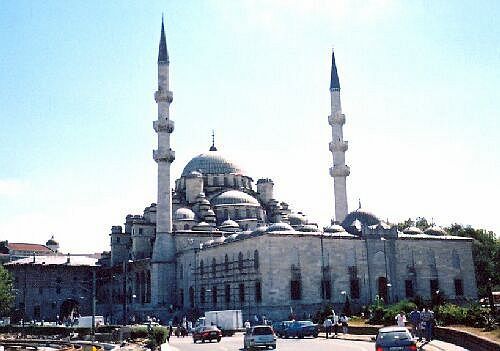
The Golden Horn
This is the name given to the flooded part of a river that flows into the Bosphorus. The name could derive from the golden appearance given by candles placed on turtle shells along the river in the 7th century. I have also heard it could rather derive from the abundance of goods that were in port.
However there is a nice spot to look over the golden horn in Pierre Loti café terrace at the top of the hill Eyüp. Pierre Loti was a French officer and writer, whose real name was Jules Viaud. He lived in Istanbul and regularly went to this cafe.
On en a une très jolie vue de l'intérieur des terres à partir de la terrasse du café Pierre Loti situé au sommet de la colline d'Eyüp. Pierre Loti était un officier et écrivain français, de son vrai nom Jules Viaud, qui séjourna à Istanbul et fréquentait régulièrement ce café.
Beaware, the café is located in fundamentalist neighborhoods so it could be better to get a guide if not sure of the way.
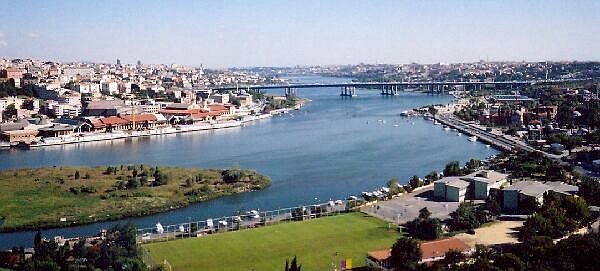
Galata Bridge, near the Egyptian Bazaar, spans the Golden Horn and lead to the Beyoğlu district. Several fishermen can be seen fishing from the bridge... But I thought the water in the Golden Horn and the Bosphorus was polluted !...
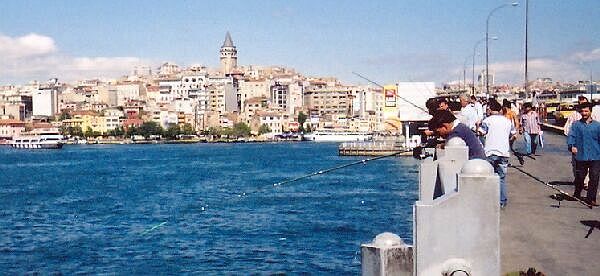
Cruise on the Bosphorus
It is not to be missed during a trip to Istanbul. Piers face the Egyptian Bazaar in Eminönü.
Leaving the Golden Horn and entering the Bosphorus, we discover a small island where only a tower has been built. It is Leander's Tower which is a landmark for ships. Then sailing up the Bosphorus towards the Black Sea, we contemplate several buildings (on the European and the Asian banks) including the Dolmabahçe Palace (see next paragraph), the two Istanbul Intercontinental bridges (the only ones in the world connecting two continents), ...
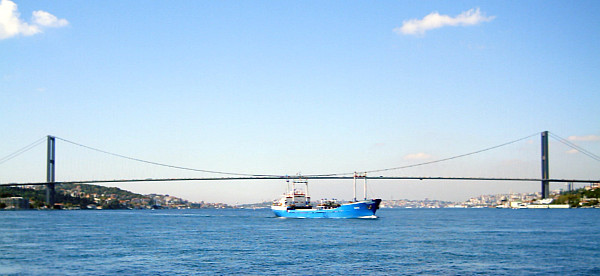
... Çırağan palace (now a luxury hotel), Beylerbeyi palace (on the Asian coast), Rumelihisarı (Rumeli fortress) built in 1452 by par Mehmet II during the siege of Constantinople, ...
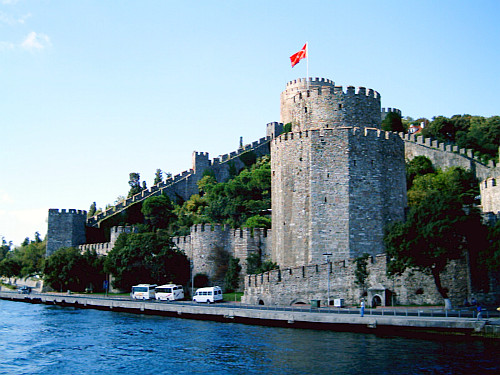
and the yalis which are houses built along the water. The term yali is of Greek origin and means "licked by the water".
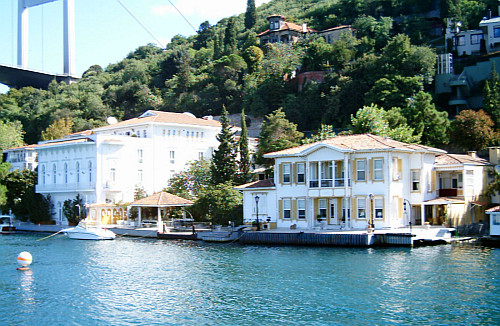
What also surprised me during the cruise is the fresh air and the numerous jellyfish that inhabit the Bosphorus. As far as I am concerned it was unexpected...
Galata tower
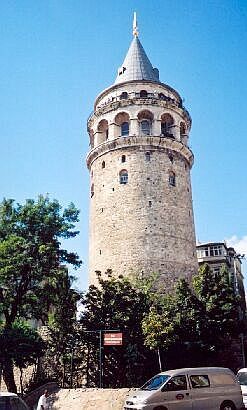
This is a 62 m (200 feet) high tower which was part of the ancient fortifications and is now the landmark of the Beyoğlu district (the new city), on the other side of the Golden Horn.
It is possible to get to the top for a panoramic view of the city.
Mevlevi Convent
This is a convent of the Sufi Muslim sect whose members are called whirling dervishes as they get into a trance while performing the sema, a spinning dance with a hand turned towards the sky (as one receives from God) and the other hand turned towards the ground (one gives back what God has given).
Sufism, which claims brotherly love whatever one's origin and religion was founded by Celâleddin-i Rûmî also known as Mevlâna.
At the convent, we can see the stage on which the Semas take place. If interested, I highly recommend attending a performance either at the convent (on Weekends) or at Sirkeci Station (on Wednesdays).
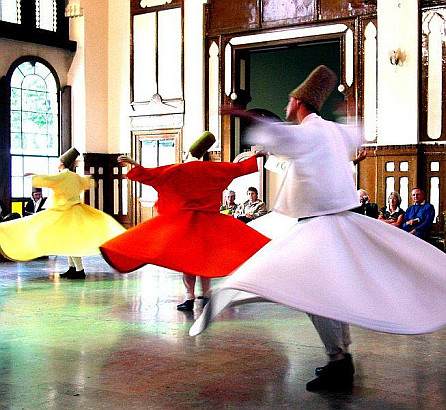
picture from shioshvili
licence Creative Commons (wikicommons)
Dolmabahçe palace
It is a baroque palace built with the influence of European style in the mid 19th century to house the sultans instead of Topkapı palace.
In summer the Janissary band plays music in front of the Imperial gate on Tuesday afternoon.
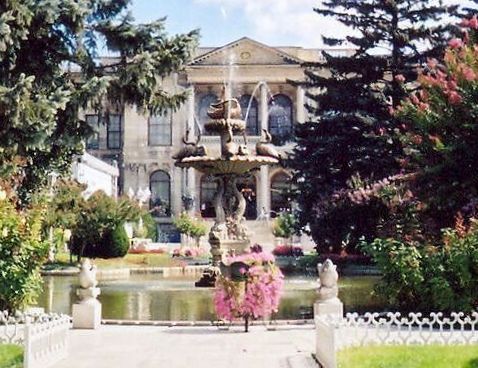
Inside, among the beautiful halls, we particularly notice the great staircase which gives an impression of lightness. The banister is made of Baccarat crystal, which makes this staircase quite impressive. It is also amazing how the crystal is present in this somptuous palace. Many chandeliers are made of Bohemian crystal or Baccarat crystal and the chandelier of the throne room would even be the heavier crystal chandelier in the world.
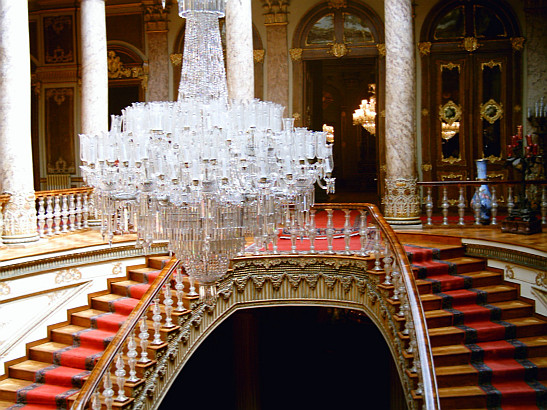
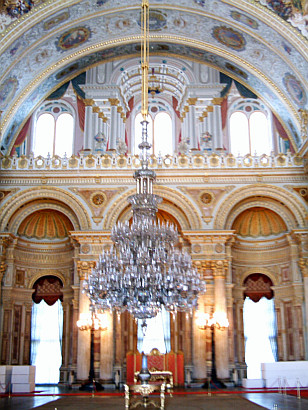
Chora church
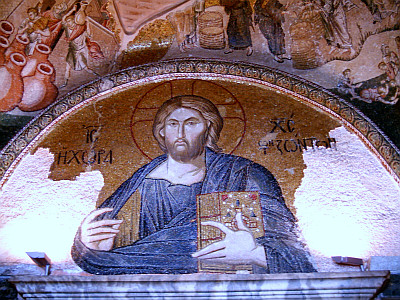
This Byzantine church is located outside the city center. As a matter of fact, "Chora" means "in the country". It was built in the period following the retaken of the city by the Byzantines from the Venitians in 1261.
The mosaics represent the childhood of Christ, the life of the Virgin and Christ's genealogy. Frescoes were completed in the Parecclesion. We can see a mosaic of Christ Pantocrator (resurrected Christ represented in a glorified body), the dome of the genealogy of Christ or the Anastasis fresco representing Christ triumphant over death and bringing Adam and Eve with him.
More visits
-
The Valens aqueduct supplied Constantinople with water.
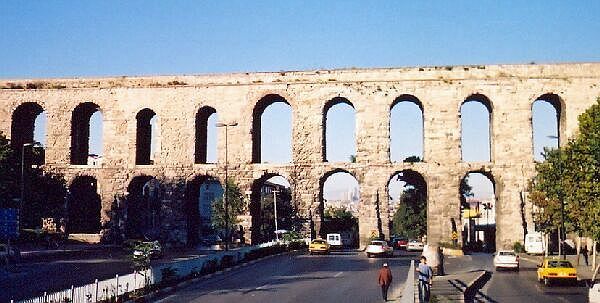
-
The city walls that extend for several kilometers.
-
Sirkeci train station was the terminus of the Orient Express.
-
Yildiz park.
-
Archaeological museum.
-
One of the numerous Turkish baths.
